Top best grape varieties for central Russia
Large and beautiful bunches of grapes are obtained in the conditions of central Russia. The main thing is to carefully consider the choice of the variety. If you plant the wrong one, the plant will often hurt, yield and the growth of young shoots will decrease. As a result, instead of delicious grapes, the summer resident will receive weak plants. Consider what to look for when choosing a variety for cultivation in central Russia.
The content of the article
Requirements for grape varieties for central Russia
For cultivation in central Russia, frost-resistant varieties are chosen. The grapes must withstand temperatures as low as -30 ° C so that the shoots do not freeze. Otherwise, the yield will decrease, the berries will grow small and fresh.
In the middle lane, plants that are resistant to viral, fungal and bacterial diseases, many of which are provoked by rain, fog and dew, take root well. Another important quality is drought tolerance. It rarely rains in some regions, and summers are dry. The quantity and quality of the crop should not be affected by the lack of moisture.
Top best
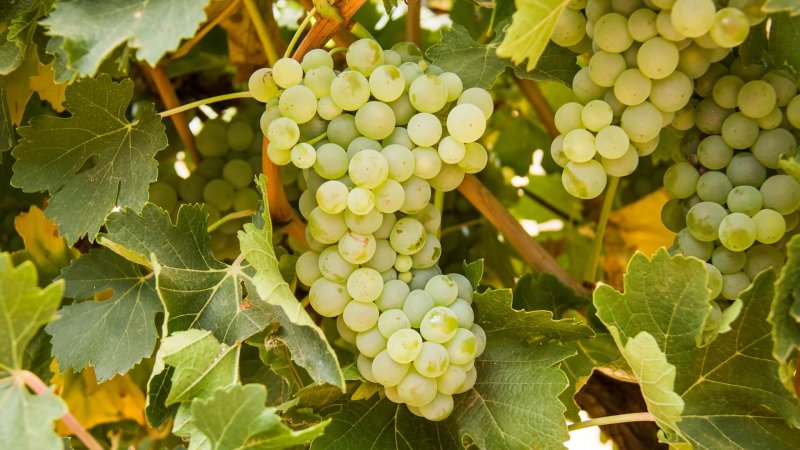
When choosing a variety, attention is paid to several criteria: taste, presentation of berries, exactingness to growing conditions, ripening period. Consider the top best grape varieties for central Russia.
Lunar
Table variety of medium early ripening. The plant is medium-sized, with large dark green leaves. The clusters are large cylindro-conical, the average weight of one is 500 g. The berries are round-oval, one-dimensional, weighing 6 g. The peel is firm, the color is white-pink, there is a slight waxy bloom. The pulp is crispy. sweet, with a pleasant nutmeg aroma. Tasting score - 8 points. Each berry contains 2-3 seeds.
The grapes can withstand frosts down to -22 ° C, they are sheltered for the winter. Resistance to powdery mildew, anthracnose, rot, septoria is increased. Lunar is rarely damaged by pests.
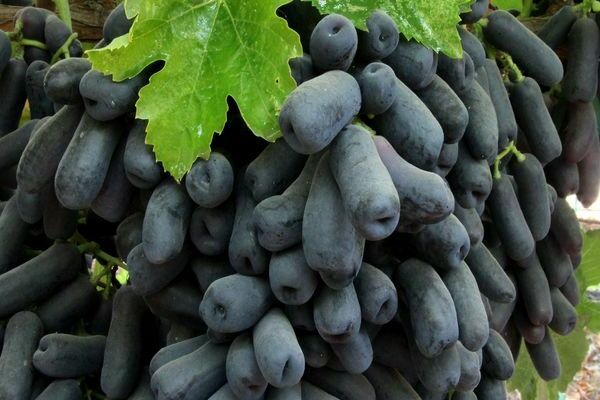
Venus
Venus grapes are raisins. It does not require special attention and is suitable for summer residents who grow crops for the first time. Venus does not require shelter for the winter and tolerates frosts without problems. Ripening period - 115–125 days, the plant is tall. Bunches of medium density, weight of one - from 200 to 600 g. Berries are blue-black, small, weighing about 2 g each. The skin is thin, easily separated from the pulp.
Interesting! Many gardeners mistakenly believe that Venus and Venus are the same cultivar. This is not so: the Venus bushes have higher bushes, in autumn the leaves are painted in a brighter orange color. They are considered similar because of the same berries and taste. Only an experienced winegrower will distinguish Venus from Venus in appearance.
The taste of Venus berries is pleasant, harmoniously nutmeg, with a pronounced grape aroma. Kishmish does not deteriorate during long-distance transportation.
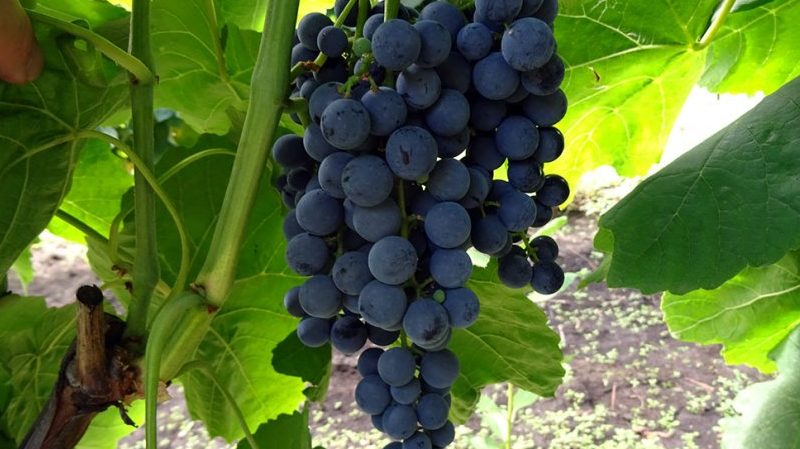
Chrysolite
Chrysolite grapes feel good in all regions of Russia: in Moscow suburbs, Volga region, Nizhny Novgorod region, in the Urals. Table variety, medium-early ripening period. The leaves are green, slightly pubescent, the shoots are flexible and powerful. The bunches are large, conical, the weight of one is about 600 g. The berries are round-ovate, the color is green-yellow. Sweet taste, nutmeg aroma, colorless juice. Tasting score - 8.6 points.
For better yield, Chrysolite is covered for the winter. Ripe berries are used to prepare jams, jellies, marshmallows, marmalade.For transportation, grapes are not used - on the road it quickly loses its taste and marketability.
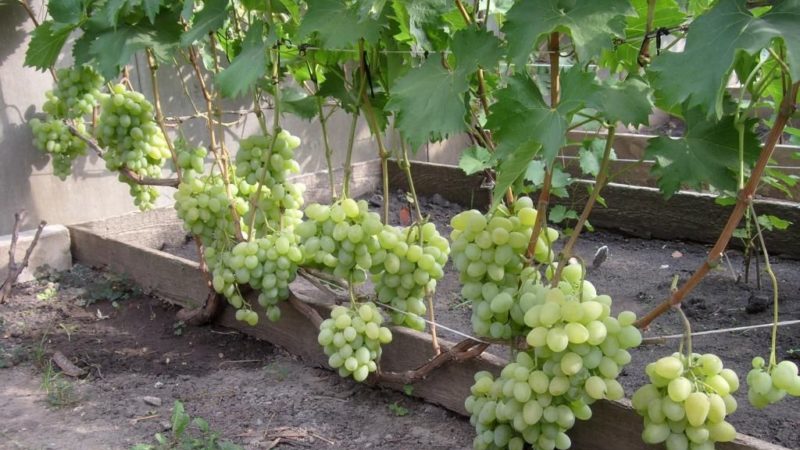
Aleshenkin's gift
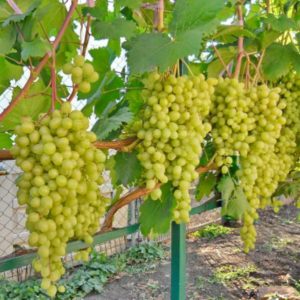
One of the most popular and productive varieties. Super early, with proper care, the berries are harvested after 110 days. The bushes are tall, with developed vines, the leaves are green, smooth and without pubescence. The bunches are loose, conical, the average weight is 0.5-1 kg, some specimens reach 2 kg. The berries are round-oval, weighing 4-5 g, the skin is translucent and firm. The color is amber, with a green tint, the juice is colorless. The taste is rich and very sweet, the tasting score is 7 points.
Aleshenkin suitable for fresh consumption and preparation of juices, compotes, jams. After processing, the berries do not lose their sweet and sugary taste. Of the shortcomings of the variety, average immunity to diseases is noted, therefore, to get a good harvest, summer residents process plant with a solution of Bordeaux liquid.
Victoria
The table variety Victoria is appreciated for its attractive commercial qualities, grown for personal consumption and sale. From the moment the buds bloom to the ripeness of the berries, 110–120 days pass. The frost resistance of the plant is up to -26 ° C, it requires shelter for the winter.
The bunches are loose, weighing from 500 to 700 g. The berries are oval red-crimson, very beautiful. The weight of one is about 5 g, the skin is dense. The pulp is sweet and aromatic, with a pleasant aftertaste. Victoria bears fruit 2-3 years after landing... Resistance to mildew is high, to septoria and rot - medium.
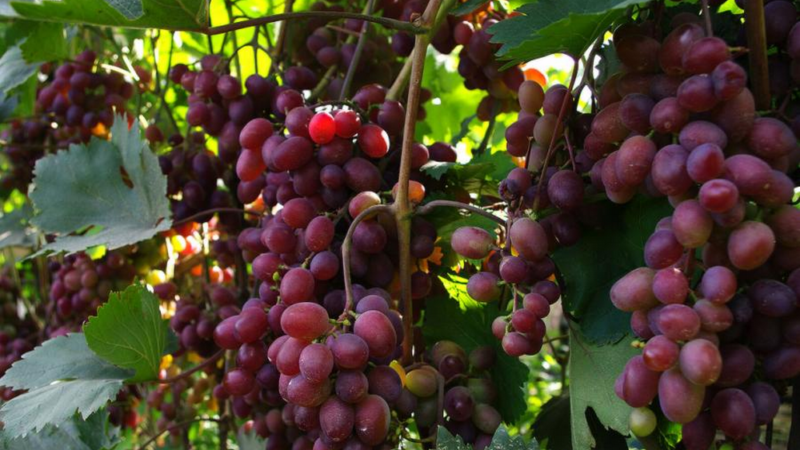
Crystal
Technical grade Crystal super early. The bushes are medium-sized, the leaves are strongly dissected, without pubescence. A cluster of medium density, weighing about 170 g. The berries are oval-round, yellow-green in color. The taste is sweet, wine and champagne are made from berries.
Summer residents note the variety's immunity to fungal diseases and frost resistance: grapes can withstand temperatures down to -35 ° C. In planting and caring for the Crystal, it does not cause difficulties, it quickly adapts to the climatic conditions of the region. It starts bearing fruit in the second year, after ripening the clusters do not crumble.
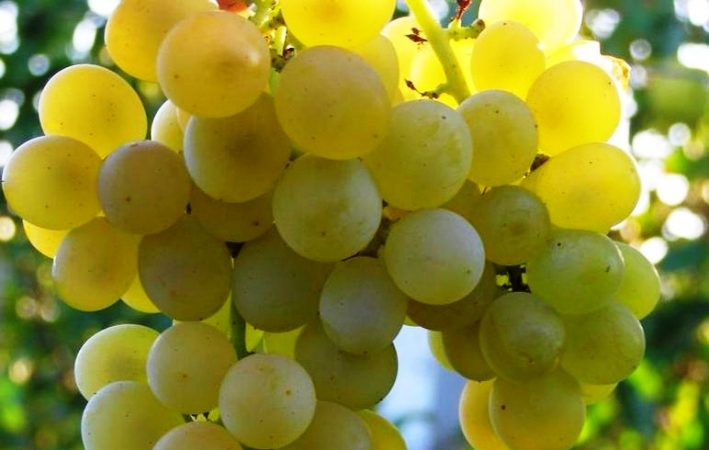
Bacchus
The technical unpretentious grape Bacchus is resistant to spring frosts, bears fruit regardless of the place of cultivation. The color of the berries is green-yellow, the skin is of medium density with a light waxy bloom. The shape of the fruit is round-oval, conical clusters are loose. Berry weight - about 4 g. The taste is harmonious, sweet, with spicy notes.
Interesting! The Bacchus variety is popular not only in Russia, but also in Germany and England. Winegrowers appreciate it for its spicy fruity aroma and early ripening. Elite wines are prepared from the fruits.
Bacchus is suitable for fresh consumption, but mostly berries are used for the production of wine, juices, champagne.
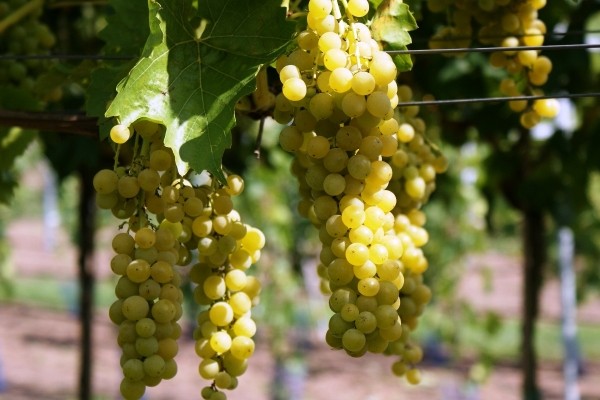
Ermak
Early ripe technical grade. Bushes are tall, with large, strongly dissected leaves. The bunches are dense, cylindrical, the average weight is 200 g. The berries are roundish black-blue. The taste is pleasant, but not too sweet. Dry wine is prepared from grapes, the tasting score of which is 7.5 points.
For the winter, the plants are not covered, which makes it easier to care for. To increase yields, old shoots are cut off. Ermak's resistance to fungal diseases is average.
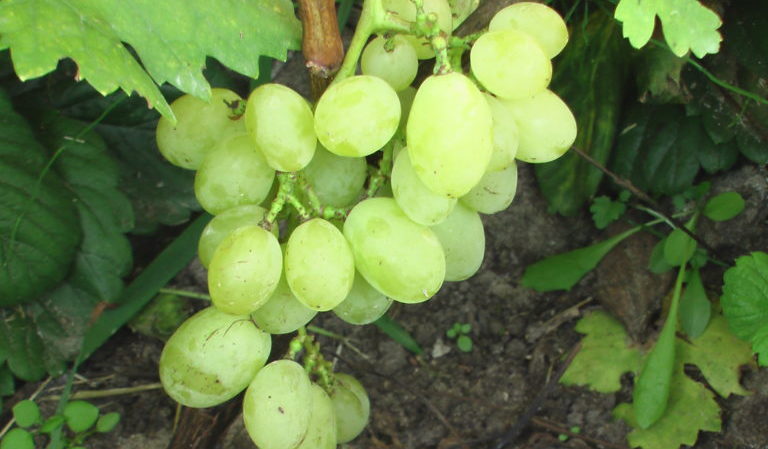
The best early, mid and late maturing grape varieties
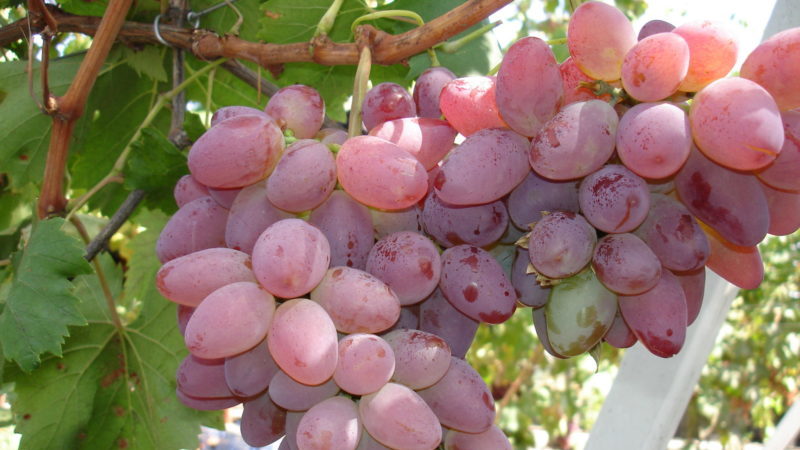
The ripening period of early varieties is 110–120 days. Some are gaining ripeness as early as 3 months from the moment the foliage blooms. Among these varieties, grapes are distinguished. Harold. The plant is frost-resistant, ripening period is 90–95 days. Bushes are tall and require timely molding. The berries are large and sweet, they are universal in use.
Summer residents distinguish the Russian early variety... The bushes are tall, powerful, when planting they are tied to trellis... The berries are round, dark pink, sugary. Russian early bears fruit for 3-4 years, resistant to fungal diseases and rot.
The ripening period of medium varieties is 120–140 days. For planting in the middle lane, summer residents choose grapes White giant - it is frost-resistant, unpretentious and high-yielding. The weight of the bunch is 1-2 kg, the weight of the berry is about 12 g. The color is white, with a waxy bloom, the skin is strong. The taste is pleasant, with a sweet aroma.
The Golden Rain grapes are also grown. The berries are oblong, yellow-green, weighing about 8 g. The taste is original: berry-fruity, with a pleasant aroma. For a rich harvest Golden shower regularly feed nitrogen and potash fertilizers.
Late varieties ripen in 140–150 days. They need constant care, not every summer resident will be able to monitor plantings for 4-5 months in a row. Late-ripening table variety Italy slightly affected by mildew and powdery mildew, gives large clusters of medium density. The berries are large, juicy, with a nutmeg flavor. Tasting score - 8.6 points.
December grapes are also in demand. The berries are dark blue, weighing about 4 g. The bunches are large, conical, the weight is about 400 g. The winter hardiness of the plant is up to -27 ° C, the vines ripen quickly. The immunity to fungal diseases is high.
Technical
Industrial varieties are grown primarily in spacious garden plots to get ripe bunches and process them into wine or juice. Summer residents choose from technical grapes:
- Solaris. Very early, high bushes. Frost resistance - up to -24 ° С, unpretentious in cultivation. The berries are golden, the taste is pleasant. Solaris produces delicious wines with a nutty-fruity aroma.
- Rondo. The ripening period is medium early, in cold regions the plant requires shelter for the winter. The grapes are resistant to mildew and bears fruit stably. The berries are dull black, the skin is thin.
- Express. Withstands frosts down to -30 ° С, does not need shelter for the winter. The bunches are loose, medium in size. The berries are black-purple, the taste is pleasant, harmonious. Grow grapes for sale.
Canteens
Table varieties grown for fresh consumption and home preservation. The berries are very sweet and juicy, with a bright aroma and aftertaste:
- Augustow. The super early variety ripens in 85–95 days. The berries are round-oval, white-green. Weight - about 3 g, medium density skin. The bunches are dense, weighing 180 g. Frost resistance of Augustowski - up to -25 ° С. The taste of the fruit is sweet.
- Alpha. It is frost-resistant, easy to grow, ripening period is average. The berries are small, round, black and blue, with a waxy coating. The skin is dense, so the grapes are well stored and transported.
- Crimean pearl. The berries are green-yellow, oval-rounded. Loose conical clusters. The pulp is juicy, with a pleasant aroma. The ripening period of the Crimean pearl is 95–105 days.
White, dark and pink
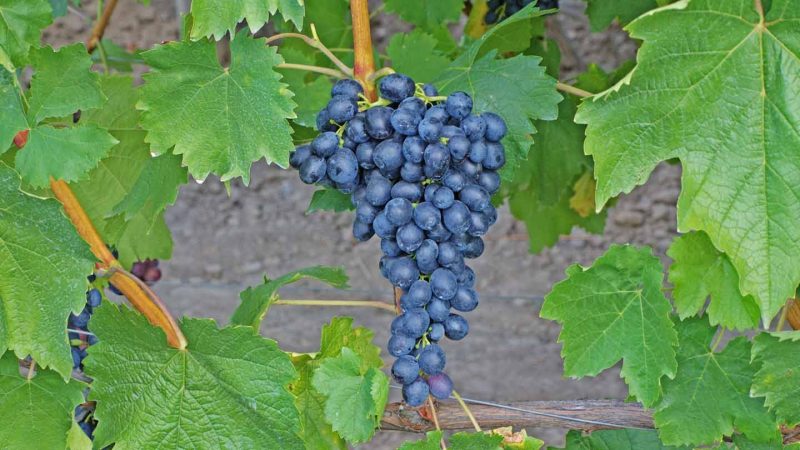
White grapes Rusbol golden color and round-oval fruits. The weight of the bunch is 400–600 g, the flesh is very juicy, the shape of the berries is round. Ripening period - 115-125 days. In application Rusbol is universal.
Summer residents celebrate the white variety Skif - technical late with a ripening period of 145 days. Bunches of medium density, berry-nutmeg taste. The berries are small and white, with a rough skin.
Summer residents choose table grapes Muromets from dark varietiesripening in 100-110 days. The berries are dark purple, weighing about 5 g, the skin is dense, with a waxy bloom. The pulp is crispy and fleshy, the taste is sweet. Ripening of shoots is good, frost resistance - up to -26 ° С.
Another dark variety Memory Dombkovskaya has a pleasant pulp and sweet aroma. Winged bunches, weighing about 350 g. The raisin harvest ripens in 115 days.
Pink variety Pink haze early maturing canteen. The berries are small, with a thin skin, so they are not suitable for transportation. The bunches are large, weighing up to 1.5 kg. The pink haze is grown for fresh consumption.
Diana grapes are chosen for wine making and processing. The bushes are weak, the leaves are pubescent. Fruits are round and small, ripen by mid-September. Frost resistance - up to -30 ° С, sweet nutmeg taste.
How to choose a complex variety for central Russia
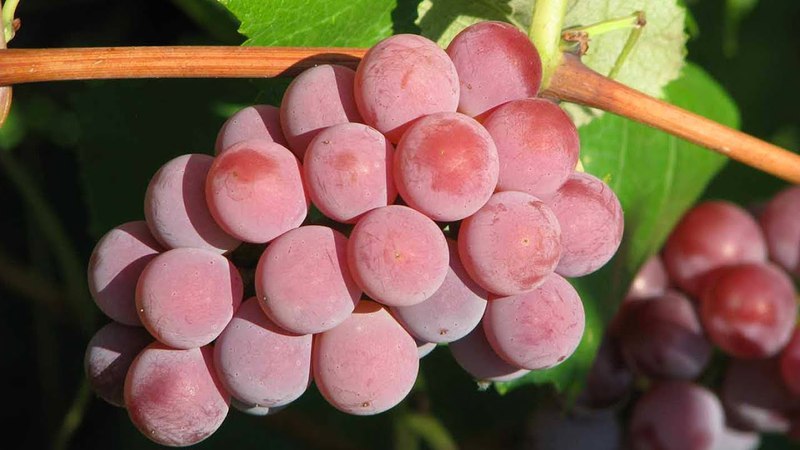
There are hundreds of domestic and foreign grape varieties. To choose the best one, it is recommended to pay attention to the following criteria:
- ripening period: early varieties are grown for fresh consumption and sale, late varieties - for processing and conservation;
- immunity: the resistance of the crop to diseases and pests makes it easier to care for it and guarantees a stable yield;
- commercial qualities: table grapes are chosen for sale, it is distinguished by larger bunches and beautiful fruits;
- taste: technical (wine) varieties are chosen for making wine, canteens for food;
- frost resistance: suitable for regions with warm winters non-covering plants, with cold - covering.
Complex resistant grapes should be distinguished by frost resistance, strong immunity, unpretentiousness. The choice of flavoring and commercial properties depends on the purpose of growing.
Conclusion
Lunny, Victoria, Kristall, Bakhus are strong and frost-resistant varieties for growing in central Russia. Summer residents choose Skif and Rusbol with white berries, Pink Haze and Diana - with pink ones. The yield, taste and commercial qualities of the fruit depend on the correct choice of the variety. Ideal grapes can withstand frost and cold, are rarely affected by fungal and viral diseases. Before buying seedlings, it is recommended to study the rating of popular varieties, their photos and descriptions.